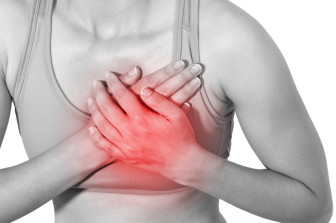Women between the ages of 30 and 55 tend to ignore early heart attack symptoms, which may be part of the reason more young women die from heart attacks than young men, according to new research by Yale School of Public Health.
Many women delay seeking medical attention when they have a heart attack because they don’t realize they are having one at first, said Judith Lichtman, associate professor and chairwoman of Yale School of Public Health’s department of chronic epidemiology.
Researchers conducted in-depth interviews with 30 women between the ages of 30 and 55 who had suffered heart attacks within the previous two weeks. The resulting research recently was published in the journal “Circulation: Cardiovascular Quality and Outcomes.”
The study focused on women who were younger than the typical demographic for heart attacks, which more often strike people in their 60s.

iStock Photo
Heart disease is the number one killer of women.
“A lot of the women had chest pain and pressure, which is the hallmark symptom of a heart attack, but also described other symptoms,” Lichtman said, such as fatigue, muscle pain and indigestion.
For many, what they experienced did not match up to the “Hollywood heart attack” commonly portrayed in movies and TV, and they didn’t realize the severity of what was happening, she said.
In some cases, women waited days before seeking medical treatment. Some, once they called their doctors, were triaged and deemed less urgent cases. One woman was offered an appointment with her doctor several days after she called and another was triaged when her doctor thought her symptoms were related to her diabetes, Lichtman said.
Another woman said she was “relieved” when she ultimately found out she’d had a heart attack; she had originally worried she was overreacting, Lichtman said.
Many of the women in the study had risk factors, including family history of heart attacks and diabetes, but still didn’t think they were having a heart attack at first, she said, which indicates more women need to be aware of the possibility.
“We need to put it on the radar for women and care providers,” she said. “We need to empower women to feel comfortable expressing their symptoms and not worry about being wrong.”
The study found that, for some women, external factors including work and family influenced whether they decided to seek emergency medical care. It also found that women did not routinely access primary care, including preventative care for heart disease, prior to having their heart attacks.
Heart disease is the No. 1 killer of women and the second leading cause of death, after cancer, among young women, Lichtman said, with more than 15,000 American women under 55 dying from heart disease each year.
Research shows women aged 18 to 55 who have heart attacks are twice as likely as men to die while in the hospital and 50 percent more likely than men to die over the following two years, Lichtman added.
“There’s something unique about this population (young women),” she said. “It’s not insignificant.”
Women with family history or other risk factors should know they are susceptible to heart attacks, even if they think they are too young, she said.
“Participants in our study said they were concerned about initiating a false alarm in case their symptoms were due to something other than a heart attack,” Lichtman said. “Identifying strategies to empower women to recognize symptoms and seek prompt care without stigma or perceived judgment may be particularly critical for young women at increased risk for heart disease.”
Yale researchers were joined in the study by researchers from Northwestern University in Illinois, Saint Luke’s Mid America Heart Institute in Missouri and the University of Missouri-Kansas City.
The study was funded by the Fannie E. Rippel Foundation and grants from the National Heart, Lung and Blood Institute.